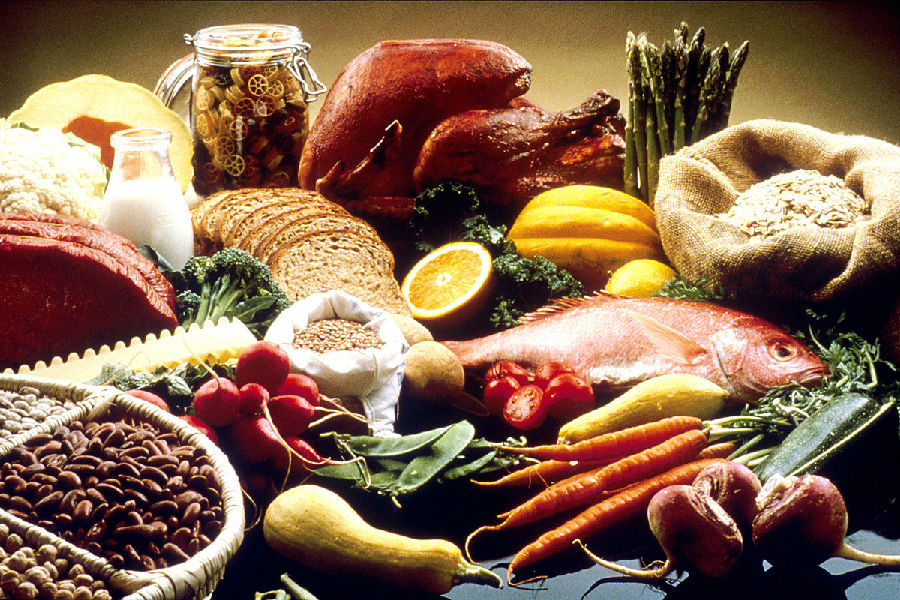The chart I'm building shows the greenhouse gas emissions from producing 1 kilogram of some common foods.
我正在制作的这个表要展示的是生产1公斤普通食物产生的温室气体的排放量。
In other words, it shows how much they contribute to global climate change.
换句话说,这个表展示的是这些食物对全球气候变化的影响。
Most fruits and vegetables are down here, with relatively low emissions.
大多数水果和蔬菜的统计条都比较低,因为它们产生的排放量相对较少。
Poultry and eggs are a little further up.
家禽和鸡蛋的稍高一些。
Pig products are here.
猪肉产品的在这个位置。
Coffee and chocolate are a little higher.
咖啡和巧克力又比猪肉高一点。
But all of these pale in comparison to this food.
但比起一种食物,刚提到的这些的排放量都算小巫见大巫的。
It's the worst thing we eat when it comes to global warming.
当我们把全球变暖问题考虑进来的时候,这种食物称得上是我们最不宜吃的食物。
This is beef.
这种食物就是……牛肉。
When you only account for the emissions that go into the processing, transportation, packaging, and selling of a food product,
如果只考虑食品在加工、运输、包装和销售过程中的排放量,
the difference between these foods isn't so great.
这些食物之间的差别其实并不是很大。
When you add the emissions from growing and processing food for livestock,
但如果我们把种植和加工鸡鸭牛羊饲料产生的排放也考虑进来的话,
you can see that animal products have higher emissions than vegetables .
你就会发现,动物食品产生的排放量要高于蔬菜类食品产生的排放量。
But the real gap comes from these two factors:
但它们之间真正的差距其实来源于两个因素:
the emissions associated with the farming process, and the impact of land use change.
一是养殖过程产生的排放量,二是土地利用变化的影响。
Coffee has such a big footprint because of the fertilizers farmers use to grow it,
咖啡的碳足迹之所以明显是因为农民在种植咖啡的时候会用到肥料,
which emit a lot of the greenhouse gas nitrous oxide.
而那些肥料会排放大量的温室气体一氧化二氮。
The farming process also accounts for most of the disparity between cow and sheep products, and everything else.
养殖环节也是牛羊产品和除牛羊之外的其他所有产品排放量差异的主要来源。
Cows and sheep have to digest food that most animals can't do as well, like grass, and tough plant material.
牛和羊食用的是大多数动物都没办法消化得很好的草料,比如青草和比较硬的树叶。
Their stomachs are microbe-rich to help them do that through a process called enteric fermentation.
因为它们的胃里有很多微生物,能够通过所谓的“肠道发酵”来帮助它们消化。
The byproduct of this digestion is methane, a powerful greenhouse gas.
这一消化机制会产生一种副产品——甲烷,而甲烷是一种非常厉害的温室气体。
Some of those emissions come out this way, but 95% come out the front.
牛羊消化草料时产生的部分甲烷会从这头排出来,但95%的都是从前面排出来的。
If you've never heard one of these animals burp,
如果你还没听过这些动物打嗝的话,
there's an endless supply of Youtube videos for your viewing pleasure.
YouTube上有海量的动物花样打嗝的视频供您食用。
"Really?"
“有没有搞错哇?”
"That was rude, sir!"
“这就是你的不对了,哥们儿!”
Jokes aside, though, methane is a huge contributor to climate change.
玩笑归玩笑,甲烷可是气候变化的罪魁祸首之一。
It's the second-most emitted greenhouse gas after carbon dioxide.
其排放量在所有温室气体中排顺数第二,仅次于二氧化碳。
But it traps more heat than carbon dioxide.
但它能吸收的热量比二氧化碳多。

Its global warming potential over 100 years is 21 times higher.
按100年算,甲烷能带来的气候变暖程度是二氧化碳的21倍。
Among human-related activities, enteric fermentation is the biggest contributor to methane emissions globally.
在与人类相关的活动中,影响全球甲烷排放最大的因素就是肠道发酵。
More so even than the methane emissions from burning fossil fuels.
肠道发酵产生的甲烷排放量甚至比燃烧化石燃料产生的甲烷排放量都多。
And it's a big reason why the farming process related emissions for beef and sheep are so high.
这也是为什么养殖牛羊产生的甲烷排放量会高出那么多的原因。
The second reason is land use change.
第二个原因是土地利用的变化。
Starting in the 1700's, the amount of land developed for humanity's purposes started to skyrocket.
从17世纪开始,为人类服务而开发的土地数量开始猛增。
Only a tiny amount of this is due to our built environment, like cities, towns and other infrastructure.
这其中,只有一小部分土地被用在了修建城市、城镇和其他基础设施等环境上。
A vast majority is for agriculture.
绝大多数开发的土地都用来搞农业了。
And when you divide that up, you see that land for grazing animals far surpasses land for growing crops.
把用于搞农业的这部分土地继续拆开来看,你会发现用于养殖牲畜的土地面积要远远超出了用于种植庄稼的土地面积。
Converting all that land to farms to make way for grazing or growing crops
把所有这些土地变成耕地来养殖牲畜和耕种农作物,
releases the carbon that was once stored in trees, other plants, and the soil.
原本储存在树木、其他植物和土壤中的碳就会被释放出来。
By contrast, nuts, and citrus fruit, and olive oil have negative land use emissions
相比之下,坚果、柑橘类水果和橄榄油因土地利用变化产生的温室气体排放量则为负数,
because planting nut, and citrus fruit, and olive trees is reforesting cropland.
因为种植坚果、柑橘类水果和橄榄树等于是在重新造林。
But chocolate has a lot of land use emissions
但巧克力因土地利用变化产生的温室气体排放量就比较高,
because cacao farming results in tropical deforestation in Southeast Asia, Africa, and South America.
因为种植可可会破坏东南亚、非洲和南美的热带森林。
And grazing animals take up a lot of space compared to crops.
其次,与种植农作物相比,养殖牲畜占据的土地空间更大。
80% of deforestation in the Amazon rainforest, for example, is to make way for cattle ranching.
举个例子,亚马逊热带雨林80%的森林砍伐都是为了给养牛场腾地。
This is how many tonnes of greenhouse gases per-capita we emit through all of our activities.
这是我们在日常活动中产生的人均温室气体排放公吨数。
Changing our diet to exclude high-emission foods has the potential to reduce that by 28% by both reducing emissions and reforesting land.
改变饮食结构,剔除高排放食物不仅能够降低这类食物造成的温室气体排放量,还有助于重新造林,带来的人均温室气体排放水平下降可达28%。
That's more than any other life change we could make.
这是我们改变其他任何生活方式都无法做到的。
A lot of food emissions are unavoidable.
食物造成的大部分温室气体排放都是不可避免的。
We have to eat.
因为我们没办法不吃东西。
But we do have a choice of what not to eat.
但吃什么不吃什么,我们还是能自己决定的。












